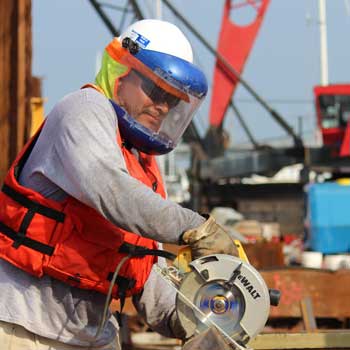It has now been more than a year since the COVID-19 pandemic arose, creating a shock wave that reverberated across seemingly all facets of life. How we shop, how we play and how we work have all felt the effects of physical distancing, masking up and other new health and safety protocols.
All industries have been impacted by COVID-19 in one way or another. Restaurant, entertainment and hospitality businesses have been devastated by the lack of in-person activities, while other fields such as shipping and IT are more important than ever.
So, one year later, how has the construction industry fared?
All things considered, the world of construction remains relatively strong. While the pandemic has slowed some projects and led to new processes, the industry continues to work hard and create new buildings and infrastructure. Like the people who make up the construction workforce, the industry is resilient and is on the road to recovery.
COVID-19 has certainly changed the look and feel of many aspects of construction. Here are some of the key ways the industry has had to adapt because of the pandemic.
Safety is an important value in construction. The ultimate goal is for everyone to get home safe at the end of the day. This was the mentality before COVID-19 came around, but the virus has added some new considerations to safety protocol.
Points of emphasis in safety have often revolved around potential hazards on the job site, such as slippery surfaces or unsecure materials. Now, a different type of hazard is around in the form of a microscopic virus. But just like other types of potential problems, preparation, awareness and following procedures goes a long way toward prevention of incidents – in this case, the spread of the virus.
Luckily, craft professionals have long been familiar with wearing personal protective equipment. Masks have joined hard hats, gloves and safety glasses among the required pieces of PPE.

Career and technical education (CTE) and craft training have traditionally looked a bit different than the average classroom, especially because of the hands-on nature of the learning and teaching.
With the pandemic forcing the closure of schools and learning centers, education predominantly moved online. Instructors and students in all subjects faced hardships in adapting to this change, but for craft training this proved especially challenging. Without in-person class sessions, the hands-on aspect of learning construction skills was hard to replicate.
Like everyone else, though, construction education has found a way to adjust. Wearing masks, rotating time slots in the workshop, safer shop layouts and other creative solutions have helped training programs continue in their mission.
Although construction remains in motion, some aspects of it have been slowed down or changed due to the pandemic. Social distancing requirements have forced some on-site teams to cut their numbers or spread out their schedule, while COVID-19 outbreaks can temporarily stop work. With the overall economy in rough shape, factors such as a client’s financial situation or rising costs of materials have also influenced both in-progress projects and future plans.
As all parties are facing unique circumstances, adaptability will be important for the near future of construction. Luckily, construction is poised to help lead economic recovery in the United States thanks to being involved in so many aspects of society. For example, the pandemic has increased the demand for single-family housing, while the ongoing need for infrastructure development will surely be a point of emphasis for the industry in coming years.
The nature of the pandemic and the calls for social and physical distancing to prevent the spread of the virus have been having an influence on how architects and design teams conceive future projects, especially offices, factories and other places where many people gather.
When the pandemic hit, many businesses found their workplaces ill-equipped to keep their employees safely spread out or isolated, which contributed to many companies shifting to a work-from-home situation.
While hopefully COVID-19 will be the only pandemic of this scale in our lifetimes, pandemic-proof accommodations will likely be a consideration for any business looking to build a new space or remodel their current one. Modular or adaptable offices with removal partitions, advanced air filtration systems, surfaces that limit transmission of bacteria and viruses, workspaces for visiting remote employees and other features could become key parts of future designs. Previous trends toward open concept floor plans and collaborative spaces may now be backtracked or approached in new ways.
Although construction has certainly changed and evolved in some ways due to the COVID-19 pandemic, there are some aspects or situations that have stayed the same or very similar to before the outbreak.
The construction industry has been facing a workforce shortage and a high demand for trained and skilled craft professionals for many years now. This has been one of the greatest threats to the long-term health and stability of the industry, and that threat still looms large.
The pandemic has indeed led to increased unemployment rates and project slowdowns, so in some ways the immediate panic about this situation has temporarily calmed down slightly. However, the issue of workforce development is not just a here-and-now issue. Looking ahead a few years down the line, what will the workforce look like?
A number of factors contribute to the skilled labor shortage. One of these is the aging construction workforce. The average age of a craft professional is between 48-52 years old, and many of the industry’s experienced employees are either approaching retirement or have already done so. Along with a growing number of people leaving the industry, not enough new young professionals are joining construction. Long-standing misconceptions and stereotypes about the industry push students and their parents away from pursuing a career in construction, while the pervasive idea that a four-year university degree is key to success funnels students toward college and away from trade schools, training programs and apprenticeships.
Slowdowns may temporarily ease demand, but shortly down the line that demand will explode again. The health crisis may have expedited retirements, while shutdowns in education have limited progress for recruiting and training the next construction generation. As we emerge on the other side of the pandemic, investing in the future of the workforce may be more important than ever.

In many ways, the pandemic has revealed which aspects of the economy are most critical. These “essential businesses” are ones that society simply could not afford to pause while many others were shutting down.
In most places in the country, construction was one of these industries that was considered essential. This status not only allowed craft professionals to keep working and projects to keep moving forward, it also gave affirmation of the importance of the construction sector and highlighted how it was connected to many different aspects of the modern world.
Consider the impact construction had on directly fighting the pandemic. Crews worked at an accelerated schedule to complete in-progress hospitals and emergency rooms, as well as convert places like convention centers into temporary medical facilities that could house more patients as existing hospitals reached capacity. Infrastructure like power grids, water systems and road networks built and maintained by the construction sector were integral to providing the utilities, resources and supplies to healthcare providers.
While the designation of being essential might have been a new official accolade for the industry, the truth is that construction has always been essential. Almost everything in the economy begins with construction: Roads, utilities, homes, commercial buildings, industrial buildings, schools, medical facilities – All require construction. Construction is one of the most important industries in the world, and the skilled craftsmen and craftswomen who power it are as integral to everyday life as any other profession.
The past year has been one of unprecedented challenges. While vaccinations and other resources will hopefully return us to relative normalcy soon, the impact of COVID-19 will continue to be felt for a long time throughout the world.
While the construction sector was not spared from problems caused by the pandemic, it has continued to work and adapt to new situations as well as any other industry. Moving forward, construction will take further steps toward recovery while also turning its attention back to other areas of focus such as workforce development. The future remains full of opportunity.